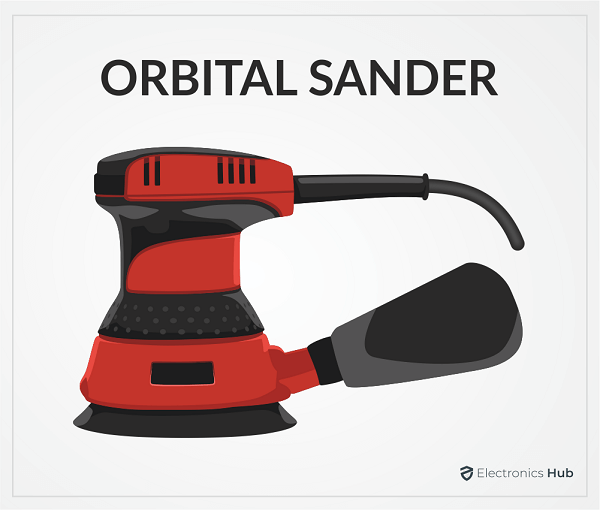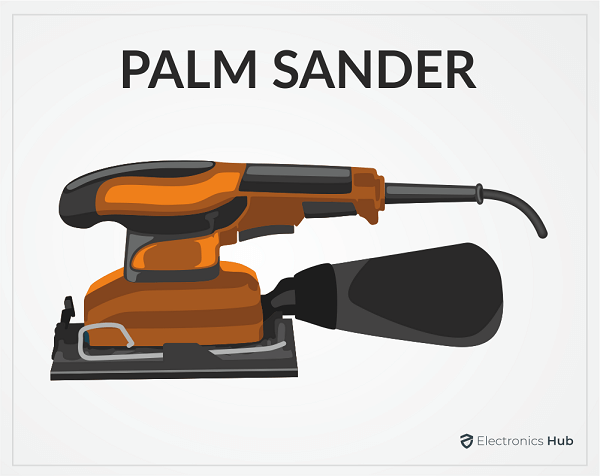Even though manual or hand sanding for up-close and fine works is still popular, the usage of power sanders is on the rise. There are different types of Power Sanders in the market, some of them are compact and portable while others are large standing machines. With a lot of sanders available, the terminology and naming also gets confusing. There seems to be a dilemma among first time tools buyers between Palm Sander vs Orbital Sander.
So, to help you out, we will discuss the basics of “Palm” Sander and Orbital Sander and understand the meaning behind their names.
We will also look at their pros and cons and find out the differences. Finally, we will make a side-by-side comparison of Palm Sander vs Orbital Sander.
Outline
ToggleWhat is an Orbital Sander?

In regular Orbital Sanders, the elliptical motion of the sanding disk might leave swirl marks on the surface of the wood. If you plan to paint on the surface, then these marks will not be a problem.
But if you are working of a final (or almost final) product, these circular marks don’t give a professional look. This is where a Random Orbital Sander comes into picture.
In this type, the motion of the circular sanding pad is random. This creates an oscillating elliptical pattern that minimizes the circular marks to give a clean finish. You don’t need additional hand sanding (small touch-ups may be necessary).
The sanding paper of the Orbital Sander has pre-drilled holes. These holes help is collecting dust. The cost of these sanding pads is very less and you can easily replace them.
What is a Palm Sander?

We usually call a small and compact size Random Orbital Sander as Palm Sander. This is because, we can operate the tool with a single hand, usually just by holding it with the palm.
If you are familiar with Sheet Sanders, that use rectangular sand paper, then we also call them as Palm Sanders.
In fact, there are several small and compact power sanders that we operate with a single hand and call them Palm Sanders. But these two i.e., the Random Orbital Sander and Sheet Sander are probably the popular types that come under Palm Sanders.
Due to their small size and relatively low power, Palm Sanders are not suitable for working on large surfaces to remove large portions. Palm Sanders are best suited for small areas, especially smoothing and finishing.
We already made dedicated comparison guides on Sheet Sander vs Orbital Sander and Belt Sander vs Orbital Sander. Check them out for additional information.
Pros and Cons
Orbital Sander
Pros:
+ Powerful Tool, suitable for sanding larger areas of wood.
+ The Random Orbital Sander is a special type of Orbital Sander that minimizes swirl marks and results in a cleaner finish.
+ You can easily replace the sanding pad with a soft pad for polishing.
+ Has dust-collection mechanism.
Cons:
– The cost is little bit more.
– Beginners might find it difficult to operate. You have to operate this tool with care by not applying too much pressure.
Palm Sander
Pros:
+ Smaller “Palm” operated versions of Random Orbital Sander or Sheet Sander.
+ Suitable for light works. Smoothing and finishing small areas.
+ Due to its small and compact size, you can easily use it in tight spaces, corners, and edges.
+ It can act as a perfect finishing tool, a tool that you can use after sanding with other larger tools
Cons:
– Low power and torque.
– Not recommended for large areas
Differences Between Palm Sander and Orbital Sander
From the above discussion, it is clear that a regular Orbital Sander or a Random Orbital Sander is the bigger brother to a Palm Sander.
You need to operate an Orbital Sander using two hands to exert the right amount of pressure and also to handle the size of the tool.
But coming to a Palm Sander, as the name suggests, you can easily operate it with a single hand, just by holding it with the palm.
Size of Palm Sander vs Orbital Sander plays an important role in the list of application they are suitable for. Random Orbital Sanders are powerful sanding tools that can handle large surfaces. You can use it to remove a significant amount of material, without any difficulty.
Palm Sanders, be it small Random Orbital Sanders or Sheet Sanders, aren’t meant for larger areas or to remove huge material. They are much more suitable for sanding or finishing small areas.
Comparison of Palm Sander vs Orbital Sander
Let us now see a side-by-side comparison of Palm Sander vs Orbital Sander. The following table has some important parameters and corresponding values for Orbital Sander and Palm Sander.
| Parameter | Orbital Sander | Palm Sander |
| Size | Relatively small but slightly larger than palm sanders. | Small and Compact. |
| Operation | Rotating sanding disk with elliptical motion. | Random elliptical motion of Circular Pad for Random Orbital Palm Sander. Back and Forth movement for Sheet Palm Sander. |
| Sanding Disk or Pad | Circular Sanding Disk or Pad. | Circular Sanding Disk for Random Orbital type Palm Sander. Rectangular Sanding Sheet for Sheet type Palm Sander. |
| Suitable For | Working on large surfaces to remove lots of material. You can use it for sanding, smoothing, finishing, and also to remove paint. | Suitable for small areas. Only smoothing and finishing. |
| Power | High power and torque | Low to medium power |
| Marks on Surface | Regular Orbital Sander might leave swirl marks. Random Orbital Sander, when careful, will not leave any circular marks. | Random Orbital type Palm Sander will not leave any marks. But Sheet type Palm Sander can leave swirl marks. |
| Cost | Higher than Palm Sanders. | Usually, less expensive. |
Palm Sander Vs Orbital Sander – FAQs
Ans: The main difference lies in their sanding motions. A palm sander typically moves in a circular motion, while an orbital sander moves in a random or orbital pattern.
Ans: Palm sanders are ideal for projects that require detailed and intricate sanding, such as furniture refinishing, cabinetry, or woodworking crafts.
Ans: Choose an orbital sander when working on larger surfaces that require fast material removal and a smoother finish. Orbital sanders are efficient for tasks like sanding large wooden panels or floors.
Ans: Orbital sanders are often more effective for paint and varnish removal due to their aggressive sanding action. However, palm sanders can also be used with appropriate grits for similar tasks.
Ans: Palm sanders typically use square or rectangular sandpaper sheets, while orbital sanders often use round sanding discs with a hook-and-loop (Velcro) attachment for easy changing.
Conclusion
First time tool buyers or beginners have a confusion among the terms Palm Sander and Orbital Sander. In this guide, we saw the basics of Orbital Sander and Palm Sander.
After that, we made a list of pros and cons for Palm Sander vs Orbital Sander. Then, we looked at some important differences between these two power tools. Finally, a side-by-side comparison of Palm Sander vs Orbital Sander in a tabular format.

